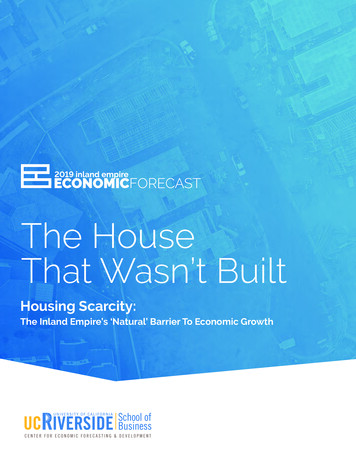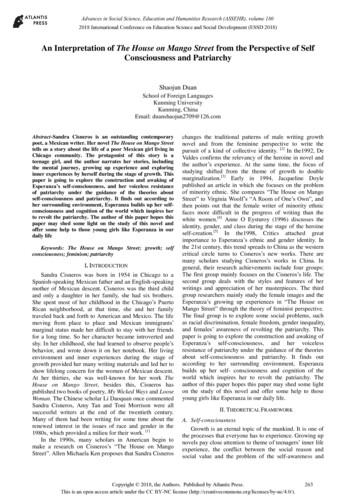
Transcription
The HouseThat Wasn’t BuiltHousing Scarcity:The Inland Empire’s ‘Natural’ Barrier To Economic Growth
Life Powered ByInnovationPremium RenewableEnergy SystemsSMX Solar Panels LED Lightingand Signage LG Home Battery Choose Technology YouCan Depend OnU P TO25year25yearWARRANTYWARRANTYINVERTERSSOLAR PANELS25yearlimitedWARRANTYWORKMANSHIP Get a FREE, no-obligationsolar consultationCall (951) 268-2614or visitwww.SolarMaxTech.comGo with California’s Renewable Energy LeaderSolarMax Technology offers premium quality solar energy systems,that are designed, engineered and assembled right here in the USA.
Riverside CountyMoving Business ForwardThe Riverside County Economic DevelopmentAgency is ready to help companies participate inthe remarkable opportunities available throughmany services and programs. Property Selectionwww.RivCoProspector.com Small Business DevelopmentAssistance Workforce Development Office of Foreign Trade Incentive Zones FinancingRIVCOBIZ.ORG
The Top Ranked MBA in the Inland EmpireUCR School of Business TOP 100 Business School UU.S.S News & World ReportRanked top 100 “Best Business Schools” – U.S. News & World Report 2019FULL-TIME MBAPROFESSIONAL MBAMASTER OF PROFESSIONAL ACCOUNTANCYMASTER OF FINANCEPHD PROGRAMGENEROUS SCHOLARSHIPS ARE CONSIDERED FOR ALL ADMITTED APPLICANTS APPLYINGBY DEADLINE. ACADEMIC AND MERIT-BASED SCHOLARSHIPS ARE ALSO AWARDED90%MBA’S EMPLOYEDWITHIN 3 MONTHSOur students intern and work at Disney, PWC, Coach, Intel,Kia Motors, Technicolor, KPMG, Monster Energy, Deloitte,Target, Bank of America, and more.School ofBusinessA . G A RY A N D E R S O N G R A D U AT E S C H O O L O F M A N A G E M E NTAGSM.UCR.edu (951) 827-6200 ucr agsm@ucr.edu
MBA INTERNSHIP PROGRAMGROW YOUR BUSINESS!Each year MBA students take internship opportunitiesto gain real world experience, develop leadershipskills, and create value for host organizations.MBAMaster of FinanceMaster of Professional AccountancyTo learn more about the Internship Programcontact the AGSM Career Development Center(951) 827-3479business.ucr.edu/cdc/employers agsmcareercenter@ucr.edu
Enriching Lives &Empowering DreamsThe Garcia FamilyMembers Since 2003At Altura you are not a customer,you’re a Member.Altura Credit Union has been a part of the Inland Empire since 1957. As a not-for-profit financial institution, we are proud to serve theunderserved and partner with our community to educate and enrich those around us.We have 14 locations in the Inland Empire and through CO-OP Financial Services our Members enjoy access to over 30,000 surcharge freeATMs and more than 5,600 shared branches across the nation.AlturaCU.coml888-883-7228Federally Insured by NCUAYou’re an inspiration to us allUCR’s School of Business is making a difference in our neighborhood.Helping the local economy thrive is just one of the many positive attributes you bring to our area. Extendingyour abilities and resources to the community through service and other initiatives makes you a true leader.We’re proud to work with UCR’s School of Business.Visit us at bankofamerica.com/local. 2019 Bank of America Corporation AR64WX5V ENT-225-AD
INNOVATIVECOUNSEL,WINNINGSTRATEGIES.ECG is proud to sponsor the10 th Annual Inland EmpireEconomic Forecast ConferenceLife is motion.In this rapidly changing world, we advise businesses andindividuals on how to prepare for the unexpected.When you partner with us, you’ll be at the center of a vastnetwork of specialists who will use their expertise in riskservices, claims management and compliance support to helpyou reach your goals.unOur unrelentingadvocacy and tailored solutions put you incontrol, and give you the peace of mind that comes fromknowing that the things that matter most to you areprotected.hubinternational.comecg.law 949-833-8550Advocacy Tailored Insurance Solutions Peace of Mindwww.moval.orgAmazonProcter & GambleKarma AutomotiveDeckers OutdoorSKECHERS USA
ONTARIOTHINKSBUSINESSAS ONE OF THE LEADERS IN SOUTHERNCALIFORNIA, THE CITY OF ONTARIO CONTINUESTO ELEVATE INVESTMENT OPPORTUNITIES ININFRASTRUCTURE TO BETTER SERVE THE NEEDSOF OUR BUSINESS COMMUNITY.WITH THREE MAJOR FREEWAYS, TWO RAILROADSAND THE ONTARIO INTERNATIONAL AIRPORT,ONTARIO IS THE PERFECT LOCATION FOR YOURBUSINESS TO THRIVE.ONTARIOTHINKSBUSINESS.COMMayor Paul S. Leon Mayor pro Tem Ruben ValenciaCouncil Members Alan D. Wapner, Jim W. Bowman, and Debra Dorst-Porada
KEEP YOUR EYESON THE ’PRISEFROM THE MARCH FIELD AIRFEST to hot air balloons in Temecula,there’s a lot to see in the skies above Riverside County. And there’sone great way to keep track of it all: The Press-Enterprise. With oursteadfast commitment to local coverage, we’re your source for the information and news that matters to you — in print, online, or on the go.Inland Southern California’s News Sourcepe.com/subscribeKUDOS TOANOTHER JOBWELL DONE.The Brandsmith would like to thank the Center for EconomicForecasting & Development and the UCR School of Businessfor another successful conference and providing us with theopportunity to serve as your creative partner.BRANDING MARKETING DESIGNwww.TheBrandsmith.agency
2019 Inland Empire Economic Forecast ConferenceAgendaNovember 6, 2019The House That Wasn’t BuiltHousing Scarcity: The Inland Empire’sNatural Barrier to Economic Growth7:30 a.m.Registration Opens8:30 a.m.Edward Ornelas, Publisher (EventEmcee)Inland Empire Business JournalWelcomeNational AnthemPerformed by Gisele Njoh NjohUniversity of California, RiversideClass of 2021Beverly Bailey, Chief Executive OfficerStronghold EngineeringOpening RemarksDr. Yunzeng Wang, DeanSchool of Business, UC RiversideOpening Remarks8:45 a.m.Dr. Christopher Thornberg, DirectorCenter for Economic Forecasting andDevelopmentSchool of Business, UC RiversideU.S. & California Forecast9:30 a.m.The Case of the Missing Homes:A Conversation Moderated byChristopher ThornbergDr. Paavo Monkkonen, AssociateProfessor of Urban Planning andPublic PolicyUniversity of California, Los AngelesSteve PonTell, Chief Executive Officerand PresidentNational CORE10:30 a.m. Dr. Robert Kleinhenz,Director of Economic ResearchCenter for Economic Forecasting andDevelopmentSchool of Business, UC RiversideInland Empire Regional Forecast11:10 a.m. Audience Q & A11:25 a.m. Adjourn and Closing Remarks
2019 Inland Empire Economic Forecast ConferenceSpeakers & PanelistsEdward Ornelas, Jr.,Publisher (Event Emcee)Inland Empire Business JournalEdward Ornelas, Jr. is a Los Angeles native, however he likes to tell people that the InlandEmpire ‘adopted him’ in 2012. He is the President and CEO of the Inland Empire RegionalChamber of Commerce and Publisher of the Inland Empire Business Journal. Having workedwith many small businesses to enhance their brand, Edward has the experience, passionand drive to succeed in any environment. A “think outside the box” attitude and unorthodoxapproach has set him apart as a marketer and leader.Formerly, as an outside sales representative for a large manufacturing company in the LosAngeles market, Edward traveled to just about every state in the U.S. meeting with key clientele,prospects, and attending trade shows.Since moving from Los Angeles to Fontana in 2011, Edward has become deeply involved in thelocal community and business community, regularly attending City Council meetings, Countymeetings, and other key regional gatherings and events that allow him to stay connected towhat’s happening across the Inland Empire.Edward has a gift for creating, envisioning, and executing marketing strategies for businessesand nonprofit organizations. Working with clients across the private and public sector, he isrecognized as a person who ‘gets things done’ and his marketing services and expertise comehighly recommended.Beverly Bailey, Chief Executive OfficerStronghold Engineering, Inc.Beverly Bailey is the president and CEO of Stronghold Engineering, Inc., a Riverside-basedgeneral contracting firm with more than 200 employees in the design-build, electrical, generaland civil construction industry. She founded the company in 1991 with her husband, Scott A.Bailey, out of their home. From 1995 to 2004, the firm grew to 185 employees, moved into a25,000 square foot Riverside corporate headquarters and added branch offices in California,Arizona, Hawaii and internationally. The company is now ranked one of the top 10 minority/women-owned construction companies in the nation.Ms. Bailey is also the CEO of Lamb Energy, a solar power construction company she foundedin 2009. In 2015, she became a Governance Fellow with The National Association of CorporateDirectors (NACD). This is the highest level of credentialing for corporate directors and corporategovernance professionals.Ms. Bailey has served on the UCR Foundation Board of Trustees since July 2019. She servedas an Executive Fellow for UCR’s School of Business during the 2017-2018 academic year. Hercurrent committee memberships include serving as Chair of the School of Business Dean’sAdvisory Council and serving on the UCRF Board of Trustees.Ms. Bailey is a managing member of Bailey California Properties, LLC, which purchased TheFarm House Motel off University Avenue in Riverside in August 2018. The motel is slated forrenovation as an indoor/outdoor center for retail shops, restaurants and entertainment.
2019 Inland Empire Economic Forecast ConferenceYunzeng Wang, DeanSchool of Business, UC RiversideYunzeng Wang was appointed permanent Dean of the UC Riverside School of Business inJanuary 2014, after serving as Interim Dean since October 2011. He joined the faculty in July2008 as the Deans’ Distinguished Scholar in Supply Chain Management and Professor of Financeand Management Science, and has served as Associate Dean of Academic Programs. Previously,Dean Wang served as faculty at Weatherhead School of Management at Case Western ReserveUniversity and the School of Management at the University of Texas at Dallas. Dean Wang has aPhD in operations management from the Wharton School at the University of Pennsylvania anda master’s degree in management sciences from the University of Waterloo, Canada.Christopher Thornberg, DirectorCenter for Economic Forecasting and DevelopmentSchool of Business, UC RiversideChristopher Thornberg is widely considered to be one of the nation’s leading economists.An expert in economic forecasting, regional economics, labor markets, economic policy, andreal estate analysis, he was one of the earliest and most adamant predictors of the subprimemortgage market crash that began in 2007, and of the global economic recession that followed.In 2015, he was named to California State Treasurer John Chiang’s Council of EconomicAdvisors. He also serves on the advisory board of Wall Street hedge fund, Paulson & Co. Inc. Dr.Thornberg holds a PhD in Business Economics from the Anderson School at UCLA.Dr. Paavo Monkkonen, , Associate Professor ofUrban Planning and Public PolicyUniversity of California, Los AngelesPaavo Monkkonen is Associate Professor of Urban Planning and Public Policy at the UCLA LuskinSchool of Public Affairs, where he is also the Director of the Latin American Cities Initiative(ciudades.luskin.ucla.edu). Professor Monkkonen researches, writes and teaches about the wayshousing policies and markets shape urban development and social segregation in cities aroundthe world. His scholarship ranges in scale from national housing finance programs to local landuse regulations, and includes comparative work on countries in the Americas (Argentina, Brazil,Mexico, and the United States) and Asia (China, Hong Kong, India, Indonesia).He continues to work as a consultant on national housing and urban policy in Mexico, wherehe has longstanding research projects, and is active in local housing politics in California. Heis on the Southern California Association of Governments (SCAG) Regional Housing NeedsAssessment (RHNA) subcommittee. Professor Monkkonen completed a Master of Public Policyat the School of Public Affairs at the University of California, Los Angeles in 2005, and a PhD inCity and Regional Planning at the University of California, Berkeley in 2009. He was AssistantProfessor of Urban Planning at the University of Hong Kong from 2009 to 2012.
2019 Inland Empire Economic Forecast ConferenceSteve PonTell, CEONational CORESteve PonTell is the Chief Executive Officer and President of National CORE. He has becomea passionate advocate for the residents and communities we serve and today is one of theleading voices and public speakers on the topic of housing affordability and communitytransformation. Mr. PonTell has led several regional and national symposiums on our nation’shousing crisis. In addition, he has addressed the California Assembly on the challenges facingthe affordable housing industry.During his career, Mr. PonTell has pursued a variety of entrepreneurial ventures and has heldseveral public-private leadership positions. Active in his community and industry, he serves onseveral boards of directors, including the California Endowment, National Housing Conference,BizFed Institute and Southern California Leadership Council. He also is an active member of theUrban Land Institute and the American Planning Association. Mr. PonTell graduated from theCalifornia Polytechnic State University — San Luis Obispo with a Bachelor of Science in City andRegional Planning and the Claremont Graduate University’s Drucker School of Business with anExecutive Master of Business Administration.Dr. Robert Kleinhenz, Director of Economic ResearchCenter for Economic Forecasting and DevelopmentSchool of Business, UC RiversideRobert Kleinhenz is one of California’s leading economists, with nearly 30 years of experienceanalyzing the U.S. and California economies and the economies of California’s many diverseregions. He is a much sought-after specialist for his deep knowledge of industries acrossthe state and in the counties of Southern California. Dr. Kleinhenz formerly served as ChiefEconomist of the Kyser Center for Economic Research at the Los Angeles County EconomicDevelopment Corporation and as Deputy Chief Economist at the California Association ofRealtors. Dr. Kleinhenz holds a PhD from the University of Southern California.
Table of Contents1United States Forecast9California Forecast15Inland Empire Forecast23Inland Empire Employment31Inland Empire Business Activity37Inland Empire Residential Real Estate49Inland Empire Commercial Real Estate65Inland Empire Demographics
UnitedStatesForecastTheRecessionThat Wasn’tSince the start of this year, the news has beenflooded with almost continuous calls that arecession is on the way. The rhetoric has shiftedfrom suggesting that the United States ‘might’have a recession in the near future to a tone ofalmost complete certainty about an oncomingdownturn and what it will mean for the election,for millennials, for whatever. The reasons forthese predictions vary—from the length of thecurrent expansion, to the trade war with China,to the ironic suggestion that the sheer bulk ofconversation about a coming recession will, byitself, create the next recession.1
Beacon Economics continuesto ignore these constant criesof wolf (or perhaps ‘bear’would be more appropriate).Our views have not changedsince the last edition of thisoutlook and, if anything,we are more bullish on theeconomy today than we wereat the start of the year. To us,the numbers don’t suggestthat the United States hassuccessfully weathered aseries of economic storms,but rather beg the questionas to whether there has beena storm to navigate. Theeconomy continues to expandat a safe and steady pace,with few of the stressors orimbalances that could cause amajor disruption. The longestexpansion in U.S. economichistory will continue for theforeseeable future.When the second quarter U.S.GDP release came out, therewas a modest revision of thelast two years of output data.The new history is almostboring in its consistency. GDPgrowth in 2019 has averaged2.55%, compared to 2.5%average growth in 2018 and2.8% in 2017. It is difficult tosee turbulence here despite allthe rhetoric to the contrary.Consumer spending has beensteady, adding slightly lessthat 2% to growth for thelast 5 years. While businessinvestment slowed somewhatin 2019, on the upside, therehas been more than enoughof a surge in public spendingto offset slower spendingfrom business. Residentialinvestment is still a drag onthe economy, although less2
United States Forecastof one than next year. And while exportshave fallen a bit, the effect on the economyhas been very small and has been offsetby modestly declining imports. In otherwords—yawn. Not much to talk about here.Moreover, it isn’t just the output data thatlooks positive. While U.S. job growth hasslowed modestly this year to about 160,000jobs per month, with the nation’s lowunemployment rate and slow growth in thelabor force, this is not surprising. The jobopenings rate in the United States is stillsignificantly higher than the unemploymentrate. Additionally, tight labor markets overthe last two years have caused wages torise at a faster pace.All this seems to stand in stark contrast tothe most talked-about stress point in theeconomy today—the trade war with China.The rhetoric surrounding the economicimpact of the current tariffs has reached analmost hysterical level. The stock marketleaps or collapses on the basis of a tweetfrom the President on the subject. Yet weare hard pressed to find a shred of datathat suggests these shifting trade flowshave had any broad, overall impact on theU.S. economy—and even struggle to findevidence for a narrow, limited impact.There is little doubt that the tariffs beingslapped onto products coming fromChina have affected trade flows with thatnation. In nominal terms, imports from3201720182019 H1GDP2.802.502.55Final 70.400.33Residential0.16-0.18-0.08Net .82-0.490.110.150.270.64Federal0.110.170.33State and local0.040.090.31GovernmentCONTRIBUTIONS TO U.S. GDP GROWTHQUARTERLY AVERAGESSource: U.S. Bureau of Economic Analysis, Analysis ByUCR Center for ForecastingChina through the first half of 2019 were down13% from the same period in 2018. Exportsresponded even more dramatically—down 19%from the previous year. But trade is fungible.Overall, the nominal value of imports andexports is largely the same as last year at thistime. Real trade flows, including services, arealso largely unchanged from 2018. One mightunderstandably wonder ‘what trade war’?
United States ForecastExportsJune. 2019 YTDYOY % GrowthImportsJune. 2019 YTDYOY % GrowthTotal 823.6-1.0%Total 1,235.80.3%Canada 148.1-3.1%China 219.0-12.4%Mexico 129.3-1.7%Mexico 179.66.3%China 52.0-18.9%Canada 158.1-1.1%Japan 36.82.6%Japan 72.93.9%UK 34.10.2%Germany 62.3-0.1%Germany 30.43.2%Korea 39.210.7%Korea 28.34.4%UK 31.05.7%Netherland 26.110.2%Vietnam 30.433.4%Brazil 20.89.3%Ireland 29.96.2%France 19.45.5%France 29.715.5%U.S. TRADE - EXPORT AND IMPORT GROWTH(IN BILLIONS)Source: WISERTrade, Analysis By UCR Center for ForecastingAdditionally, inflation has not heated up asa result of tariffs on imports—it has actuallyslowed to a modest 1.5%. Even for productsthat are imported directly, we see littledifference in price growth as a result of thetariffs. Inflation rates over the last year were1% for apparel, 2.4% for furniture, 2.2% fortires, and AV equipment was actually downby a whopping 9.8%. Dishes and flatwaredid rise by 8%, but it seems unlikely that thehigher cost of new tableware will push the U.S.consumer to the breaking point. Much of this isbeing driven by the fact that the Chinese haveallowed their currency to depreciate sharply,to over 7 yuan per dollar, meaning they havepicked up most of the cost of the tariffs. Inshort, the only true macroeconomic effect ofthe trade war has been in the news/mediabusiness.2019 H1Furniture and bedding2.40Appliances0.10Dishes and flatware8.00Tools, hardware2.30Apparel1.00Tires2.20Video and audio products-9.80Sporting goods0.00CPI INFLATION RATEAUGUST 2018 TO AUGUST 2019Source: U.S. Bureau of Labor Statistics, Analysis ByUCR Center for Forecasting4
United States %INDUSTRIAL PRODUCTION: MANUFACTURING(YEAR-OVER-YEAR)Source: Board of Governors of the Federal Reserve System, Analysis by UCR Center for ForecastingWhile it’s true thatmanufacturing output hasflattened, it isn’t much of astressor on the economy. In2016, industrial productionwent negative in the midst ofthe global commodity bust.Yet this was barely seen inoverall growth at the nationallevel. A huge share of the U.S.economy today is in services,making it far more immune tomanufacturing cycles.5As for why manufacturing isflat, a portion is indeed beingdriven by flattening exports,but another, perhaps evenmore significant portion,stems from weak businessinvestment. The slowdownin business investment isnot too surprising given thestrong numbers over the lasttwo years, much of whichwas driven by the accelerateddepreciation giveaway in theTax Cuts and Jobs Act of 2017.And countering this modestnegative is plenty of goodnews. On the upside, fallinginterest rates are alreadystarting to create newmomentum in residential realestate. Home sales are pickingup and new home sales areback to a 12-year high (albeitstill much lower than in 2006).Home price growth is alsostabilizing. Additionally, expecta wave of refinancing onhomes (interest rates are backto 3.5%!) as consumers move
United States 5%U.S. HOME PRICE GROWTH(YEAR-OVER-YEAR)Source: S&P Dow Jones Indices LLC, S&P/Case-Shiller 20-City Composite Home Price Index, Analysis by UCR Centerfor 04Jan-040U.S. SINGLE-FAMILY HOMES SOLD(IN THOUSANDS)Source: Board of Governors of the Federal Reserve System, Analysis by UCR Center for Forecasting6
United States c-06May-06Oct-05Mar-05Aug-04Jan-040PERSONAL SAVINGS AS A PERCENTAGE OF DISPOSABLE PERSONAL INCOMESource: U.S. Bureau of Economic Analysis, Analysis by UCR Center for Forecastingto save even more on theirinterest payments. BeaconEconomics expects real estateto become a positive force forgrowth in the second half ofthe year and even more so in2020.Speaking of consumers, therewere a number of pleasantsurprises in the revisedGDP data, including another7upward revision in consumersavings rates. The rate iscurrently at 8%, the highestsince the early 1990s (outsideof an odd surge prior to taxesgoing up in 2012). Americansare actually tucking moneyaway. Combined with lowinterest rates and a slow paceof household debt growth,the financial obligations ratiocontinues along at a recordlow level. The U.S. consumersector hasn’t been this healthyin two decades, and a healthyconsumer sector can pushthe nation through any majorissues in the global economy.One of the big questions ishow we square our benignview of the economy with theinverted yield curve, whichhistorically is one of the best
United States Forecastpredictors of an oncomingrecession. The answer is tounderstand that correlationis not causation—short runinterest rates being higherthan long run interest rateshas never, by itself, created arecession. Rather, the strongcorrelation in this data isdriven traditionally by theFederal Reserve raising shortrun interest rates to try andcool an overheating economy.In other words, the invertedyield curve is like the skidmarks at the top of a cliff. Itis a sign of trying to avoid anaccident.Economics’ expects GDPgrowth to continue at a steady2.5% pace for the foreseeablefuture. Unemployment willremain low and wages willcontinue to rise. Also, expecthousing prices to accelerate.The good news is that theAs for when exactly the nextUnited States is not currentlyrecession might arrivefacing a cliff. The U.S. economy — we simply don’t know.is stable and the expansionwill continue. Beacon8
California ForecastFact Versus FictionBy Robert Kleinhenz, Executive Director of ResearchWhile still savoring the fact that the U.S. economy is the midst of a record-breaking expansion,attention has suddenly shifted to questions about when the next recession will begin. Admittedly, thereare a number of mounting concerns: U.S. trade conflicts, weaker global economic conditions, Brexit,and the inverted yield curve. Still, despite the uncertainty that has fueled these concerns, and despitechronic homegrown problems with respect to the labor force and housing, California’s economy hasperformed solidly through the first half of the year, and will stay on track into 2020.Just the Facts, Ma’amLooking beyond the rhetoric and headlinecatching hyperbole, data clearly show aCalifornia economy that is humming along. Thestate’s unemployment rate, having hit a recordlow of 4.1% in July 2018, has been skating alongat that rate, or slightly above, in the monthssince. Jobs grew statewide at a year-over-yearrate of 1.8% in July 2019, comfortably abovethe long run growth rate (since 1991) of 1.2%and a just a hair behind last year’s 1.9% rate of9expansion. And with a tight labor market andsteady job growth, wages continue to climb.California added 311,800 jobs year-over-year asof July, and has accounted for 16% of job gainsnationally through the first seven months of2019, essentially unchanged from the previousfive years. Health Care, Professional Scientificand Technical Services, Leisure and Hospitality,and Construction led the way in absolute terms,
Industryaccounting for roughly twothirds of the state’s total jobgains.Each of these industries isdriven by its own dynamic.Health Care has been ona sustained growth pathfor several years, while theadvances in ProfessionalScientific and TechnicalServices show the strengthof the state’s tech sector.Meanwhile, gains in Leisureand Hospitality employmentare a reflection of spendingfrom household and businessdiscretionary income.Construction, ProfessionalScientific and TechnicalJuly '19YTY ChangeYTY % ChangeTotal Nonfarm17,488,600311,8001.8%Health Care & Social Assistance2,433,60074,4003.2%Professional, Scientific & TechnicalServices1,327,40046,5003.6%Leisure & ve & Support & WasteServices1,159,60030,4002.7%Transportation, Warehousing & 2.8%1,337,90012,8001.0%Educational Services382,7008,4002.2%Real Estate & Rental & Leasing296,7003,7001.3%Other Services576,5002,0000.3%Management of Companies & nance & Insurance542,600-600-0.1%Wholesale uringRetail TradeJOB GAINS ACROSS NEARLY ALL INDUSTRIESSource: California Employment Development Department, Analysis by UCRCenter for Forecasting10
California ForecastServices, and HealthCare were also leaders inpercentage terms, followedby Information. On the otherhand, five of the state’s 17major industries contracted,losing a total of 13,600 jobsfrom July 2018 to July 2019(less than 0.1% of the state’stotal payroll employment).Evidence of growth can alsobe seen early in the year,in real gross state product,which was up 2.7% year-toyear in the first quarter, andin nominal personal income,which advanced by 3.1% overthe same period, slightly offthe national pace in bothcases. When viewed alongsidethe 8.1% increase in statewidetaxable sales over this sameperiod, it appears that bothhousehold and businessspending have the wherewithalto fuel continued spending.Regionally, Los Angeles Countyled the state in job growth inJuly 2019 with an increase of59,400 positions, followed bySan Francisco MD (41,100),the Inland Empire (35,700),and San Jose (33,500). All buttwo metro areas in the state11MSAJuly '19YTYChangeYTY %ChangeLos Angeles-Long Beach-Glendale Metro Div4,568,60059,4001.3%San Francisco-Redwood City-South San FranciscoMetro Div1,186,50041,1003.6%Riverside-San Bernardino-Ontario MSA1,545,40035,7002.4%San Jose-Sunnyvale-Santa Clara MSA1,161,10033,5003.0%San Diego-Carlsbad MSA1,514,00027,6001.9%Anaheim-Santa Ana-Irvine Metro Div1,677,60025,8001.6%Oakland-Hayward-Berkeley Metro -Arcade MSA1,020,90019,7002.0%Fresno MSA363,70012,1003.4%Bakersfield MSA273,2006,8002.6%Santa Maria-Santa Barbara MSA189,7006,1003.3%Salinas MSA148,1005,3003.7%San Rafael MD119,9003,4002.9%Visalia-Porterville MSA128,4003,2002.6%Santa Rosa MSA212,0003,1001.5%Modesto MSA180,0002,7001.5%San Luis Obispo-Paso Robles-Arroyo Grande MSA120,1002,5002.1%Santa Cruz-Watsonville MSA104,6002,2002.1%Merced MSA70,1001,6002.3%Napa MSA75,7001,4001.9%Oxnard-Thousand Oaks-Ventura MSA310,8001,1000.4%Chico MSA84,5001,1001.3%Hanford-Corcoran MSA41,3001,0002.5%Yuba City MSA45,4001,0002.3%Redding MSA68,0001,0001.5%Madera MSA38,7005001.3%El Centro MSA52,0003000.6%Vallejo-Fairfield MSA141,900-200-0.1%Stockton-Lodi MSA240,800-200-0.1%CALIFORNIA REGIONAL GROWTH CONTINUESSource: California Em
The Riverside County Economic Development Agency is ready to help companies participate in the remarkable opportunities available through many services and programs. Riverside County Moving Business Forward Property Selection www.RivCoProspector.com Small Business Development Assist











